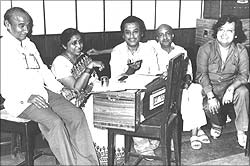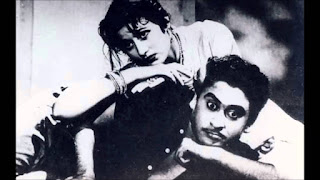Nasir Hussain (16 November 1926 – 13 March 2002) had a ear for good, popular music.He gave us many Musical Hits like Jab Pyar Kisi Se Hota Hai (1961), Phir Wohi Dil Laya Hoon (1963), Teesri Manzil (1966), Baharon Ke Sapne(1967), Pyar Ka Mausam (1969), Caravan (1971), Yaadon Ki Baraat (1973), Hum Kisise Kum Naheen (1977). Qayamat Se Qayamat Tak (1988) and Jo Jeeta Wohi Sikander (1992).
He started his career as story writer in 1948. The famous films he wrote for Filmistan include Anarkali (1953), Munimji (1955), and Paying Guest (1957).
He directed his first film Tumsa Nahin Dekha in 1957 which established Shammi Kapoor as a successful Actor.
He was very fond of Dev Anand,he wanted Dev Anand to be Hero of Tumsa Nahin Dekha and Teesri Manzil but Dev Anand did not acept his offer,both the films went to Shammi Kapoor.
He also introduced Asha Parekh from Dil Deke Dekho( 1959).After that he had one of his longest associations was with leading lady Asha Parekh, from Dil Deke Dekho, through Jab Pyar Kisise Hota Hai, Phir Wohi Dil Laya Hoon, Teesri Manzil, Baharon Ke Sapne, Pyar Ka Mausam until Caravan. After a gap of 13 years, she did a cameo in his film Manzil Manzil (1984).
Rajendra Nath the comedian was a fixture in almost all of his early productions. He was in Dil Deke Dekho (1959), Jab Pyar Kisise Hota Hai (1961), Phir Wohi Dil Laya Hoon (1963), Baharon Ke Sapne (1967), Pyar Ka Mausam (1969), Zabardast (1985) and Zamaane Ko Dikhana Hai (1981).
R D Burman was another person who had a long association with him since Teesri Manzil through Baharon Ke Sapne, Pyar Ka Mausam, Caravan, Yaadon Ki Baraat, Hum Kisise Kum Naheen, Zamane Ko Dikhana Hai, Manzil Manzil and Zabardast.
Another person was the lyricist Majroh Sultanpuri who was associated with him in 10 of his productions, apart from working with him in Paying Guest.
In the 80s he lost his magic touch,none of his films were clicking on the Box Office.In 1981 he made Zamane Ko Dikhana Hai but the film flopped, Undeterred, he directed his next film Manzil Manzil(1984) and brought back Asha for a small cameo in the mother role, but the film still flopped. As did his next film Zabardast (1985), which turned out to be his last directorial venture. He then handed the reins over to his son Mansoor Khan to direct Qayamat Se Qayamat Tak (1988), which starred his nephew Aamir Khan, which became a big hit. Since Nasir wrote the script, he won the Filmfare Best Screenplay Award. He would win the Filmfare Best Movie Award for producing Mansoor's directorial effort Jo Jeeta Wohi Sikandar (1992), which again starred his nephew Aamir Khan. The final film he wrote was Akele Hum Akele Tum (1995). He won a special Filmfare Award for his contribution to Hindi cinema in 1996.
He was a big fan of Western music — be it the Beatles, Jose Feliciano, Abba, the Elvis Presley songs and these are all referenced in his films. I think this too contributed to his excellent working relationship with R D Burman.He died of a heart attack on March 13, 2002.He will be remembered for his musical hits.
Super Hit songs from Nasir Hussain Films
Song from Tumsa Nahin Dekha 1957
Song from Dil Deke Dekho 1959
Song from Jab Pyar Kisi Se Hota Hai 1961
Song from Phir Wohi Dil Laya Hoon 1963
Song from Baharon Ke Sapne 1967
Song from Pyar Ka Mausam 1969
Song from Caravan 1971
Song from Yaadon Ki Baaraat 1973
Song from Hum Kisise Kum Naheen 1977
Song from Qayamat Se Qayamat Tak (1988)
Song from Jo Jeeta Wohi Sikander (1992)


















